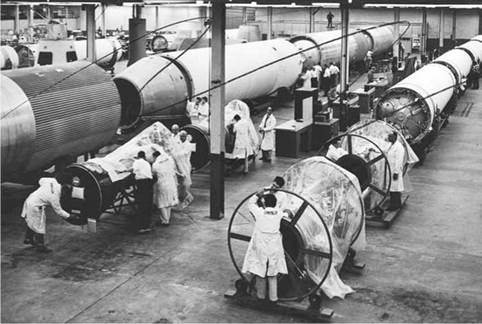THE FIRST REDSTONES
Using their V-2 experience, and under orders from the Pentagon to develop a large tactical rocket capable of delivering a nuclear warhead a distance in excess of 200 miles, von Braun and his team manufactured and tested in-house a number of 69-foot prototype rockets before the task was handed over to a production contractor. These missiles were powered by a liquid-propellant engine developed by the Rocketdyne Division of North American Aviation that delivered a thrust of some 78,000 pounds.
Not surprisingly, given the involvement of so many German rocket engineers and technicians, the missile evolved with a number of similarities to the V-2 rocket, but with major improvements. “When completed, the Redstone represented an important advance over the V-2,” wrote Von Hardesty and Gene Eisman in Epic Rivalry: The Inside Story of the Soviet and American Space Race. “The Redstone’s warhead and guidance system, for example, was contained in a reentry vehicle that separated from the main body of the rocket (unlike the V-2, where the entire rocket body returned to Earth in one piece). The guidance system used a computer and an inertial navigation system contained in the warhead and relied totally upon onboard instruments. To reduce the missile’s weight, the fuel tanks were formed by the outer surface of the rocket rather than being housed separately inside it.” [2]
Following static and ground testing at Huntsville, the launch-ready missiles were to be transported to Cape Canaveral for firing from the test range. Retired engineer Allen Williams worked on the Redstone missile project. In 1952, while employed as a professor in mechanical engineering at Louisiana Polytechnic Institute in Ruston, Louisiana, he was approached by the Thiokol Chemical Corporation with an offer to take over the Redstone project, which was then experiencing some difficulties with the rocket engine. He decided to take up the challenge and relocated to the Redstone Arsenal to work with the German rocket scientists.
“When I took the job over, it was in serious trouble; everyone told me it would not be successful,” Williams said. “But we managed to overcome the problems and scheduled flight tests at Cape Canaveral with four test shots of non-guided rockets. Things [in those days] were so unsophisticated. Cape Canaveral was a town of just about 500 people. We drove our test rockets through the town hidden under covers. The project was supposed to be secret, but we had to remove the stop lights in the town to let the rockets pass through. We did this with just about everyone in town standing around watching!”
As Williams recalled, facilities at the Cape in 1952 included only four concrete pads about 20 yards square and a blockhouse for observers, while launch warnings and tracking were fairly rudimentary affairs, as he cited in one example. “We sent planes out over the ocean to warn people to get away from the area. We didn’t know where the rocket would go, but we thought it might have a range of 75 nautical miles [about 83 statute miles]. We sent out trace planes to follow the first shot. The rocket had dye-markers on it to indicate its impact area in the ocean. The plane couldn’t find it at first, but 50 miles out in the ocean [the pilot] picked up the dye-markers.
“Three weeks later we held another launch, but the wind was much stronger than usual. We held the launch for the wind to die down. When we did launch the rocket, it took off and was carried like an arrow by the wind, parallel to the south coast of Florida; we tried to blow it up, but the destruct mechanism failed.” Williams went on to become Thiokol’s director of engineering in Elkton, Maryland [3].
|
The Redstone production assembly line at the Chrysler Corporation. The rockets pictured are the Jupiter variant of the Redstone. (Photo: Chrysler Corporation) |











